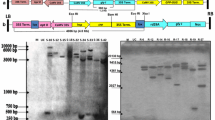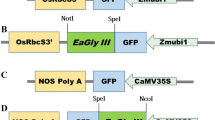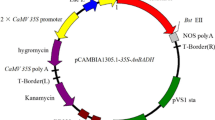Abstract
Glyoxalase I is the first enzyme of the glyoxalase system that can detoxify methylglyoxal, a cytotoxic compound increased rapidly under stress conditions. Here we report cloning and characterization of a glyoxalase I from sugar beet M14 line (an interspecific hybrid between a wild species Beta corolliflora Zoss and a cultivated species B. vulgaris L). The full-length gene BvM14-glyoxalase I has 1,449 bp in length with an open reading frame of 1,065 bp encoding 354 amino acids. Sequence analysis shows the conserved glyoxalase I domains, metal and glutathione binding sites and secondary structure (α-helixes and β-sheets). The BvM14-glyoxalase I gene was ubiquitously expressed in different tissues of sugar beet M14 line and up-regulated in response to salt, mannitol and oxidative stresses. Heterologous expression of BvM14-glyoxalase I could increase E. coli tolerance to methylglyoxal. Transgenic tobacco plants constitutively expressing BvM14-glyoxalase I were generated. Both leaf discs and seedlings showed significant tolerance to methylglyoxal, salt, mannitol and H2O2. These results suggest an important role of BvM14-glyoxalase I in cellular detoxification and tolerance to abiotic stresses.






Similar content being viewed by others
References
Arnon DI (1949) Copper enzymes in isolated chloroplasts: polyphenol oxidase in Beta vulgaris. Plant Physiol 24:1–15
Baker CJ, Mock MM (1994) An improved method for monitoring cell death in cell suspension and leaf disc assays using Evans blue. Plant Cell Tissue Organ Cult 39:7–12
Bradford MN (1976) A rapid and sensitive method for the quantitation of microgram quantities of protein utilizing the principle of protein-dye binding. Anal Biochem 72:248–254
Chakravarty TN, Sopory SK (1998) Blue light stimulation of cell proliferation and glyoxalase I activity in callus cultures of Amaranthus paniculatus. Plant Sci 132:63–69
Chaplen F, Fahl W, Cameron D (1998) Evidence of high levels of methylglyoxal in cultured Chinese hamster ovary cells. Proc Natl Acad Sci 95:5533–5538
Desel C, Jansen R, Dedong G, Schmidt T (2002) Painting of parental chromatin in Beta hybrids by multi-colour fluorescent in situ hybridization. Ann Bot 89:171–181
Deswal R, Sopory SK (1999) Glyoxalase I from Brassica juncea is a calmodulin stimulated protein. Biochim Biophys Acta 1450:460–467
Deswal R, Chakaravarty TN, Sopory SK (1993) The glyoxalase system in higher plants: regulation in growth and differentiation. Biochem Soc Trans 21:527–530
Espartero J, Sánchez-Aguayo I, Pardo JM (1995) Molecular characterization of glyoxalase-I from a higher plant; upregulation by stress. Plant Mol Biol 29:1223–1233
Fan L, Zheng S, Wang X (1997) Antisense suppression of phospholipase Dα retards abscisic acid- and ethylene-promoted senescence of postharvest Arabidopsis leaves. Plant Cell 9:2183–2196
Gao D, Guo D, Jung C (2001) Monosomic addition lines of Beta corolliflora Zoss in sugar beet: cytological and molecular-marker analysis. Theor Appl Genet 103:240–247
Ge Y, He G, Wang Z, Guo D, Qin R, Li R (2007) GISH and BAC FISH study of apomictic Beta M14. Sci China C Life Sci 50:242–250
Ghoul am C, Foursy A, Fares K (2002) Effects of salt stress on growth, inorganic ions and proline accumulation in relation to osmotic adjustment in five sugar beet cultivars. Environ Exp Bot 47:39–50
Guo D, Liu L, Cang C, Li H, Han X, Tang Y, Wang G (2001a) Analysis of the transmission frequency of a monosomic addition line of Beta corolliflora Zoss in sugar beet. J Heilonjiang Univ 18:102–107
Guo D, Lu L, Kang C (2001b) Propagation and transmitting characteristics of apomictic monosomic additions Beta M14. J Heilonjiang Univ 18:104–107
Hameed A, FarooQ S, Iqbal N, Arshad R (2004) Influence of exogenous application of hydrogen peroxide on root and seedling growth on wheat (Triticum aestivum L.). Inter J Agr Biol 6:366–369
Han W, Ding P, Xu M, Wang L, Rui M, Shi S, Liu Y, Zheng Y, Chen Y, Yang T, Ma D (2003) Identification of eight genes encoding chemokine-like factor superfamily members 1–8(CKLFSF1–8) by in silico cloning and experimental validation. Genomics 81:609–617
Horsch RB, Fry JE, Hoffmann NL, Eichholtz D, Rogers SG, Fraley RT (1985) A simple and general method for transferring genes into plants. Science 227:1229–1231
Inoue Y, Maeta K, Nomura W (2011) Glyoxalase system in yeasts: structure, function, and physiology. Semin Cell Dev Biol 22:278–284
Kalapos MP (2008) The tandem of free radicals and methylglyoxal. Chem Biol Interact 171:251–271
Laemmli UK (1970) Cleavage of structural proteins during the assembly of the head of the bacteriophage T4. Nature 227:680–685
Li Y, Cohenford MA, Dutta U, Dain JA (2008) The structural modification of DNA nucleosides by nonenzymatic glycation: an in vitro study based on the reactions of glyoxal and methylglyoxal with 2′-deoxyguanosine. Anal Bioanal Chem 390:679–688
Li H, Cao H, Wang Y, Qiu P, Chun Ma, Si C (2009) Proteomic analysis of sugar beet apomictic monosomic addition line M14. J Proteomics 73:297–308
Lin F, Xu J, Shi J, Li H, Li B (2010) Molecular cloning and characterization of a novel glyoxalase I gene TaGLY I in wheat (Triticum aestivum L.). Mol Biol Rep 37:729–735
Maeta K, Izawa S, Inoue Y (2005) Methylglyoxal, a metabolite derived from glycolysis, functions as a signal initiator of the high osmolarity glycerol-mitogen-activated protein kinase cascade and calcineurin/Crz1-mediated pathway in Saccharomyces cerevisiae. J Biol Chem 280:253–260
Martins AM, Cordeiro CA, Ponces Freire AM (2001) In situ analysis of methylglyoxal metabolism in Saccharomyces cerevisiae. FEBS Lett 499:41–44
McGuffin LJ, Bryson K, Jones DT (2000) The PSI-PRED protein structure prediction server. Bioinformatics 16:404–405
Mustafiz A, Singh AK, Pareek A, Sopory SK, Singla-Pareek SL (2011) Genome-wide analysis of rice and Arabidopsis identifies two glyoxalase genes that are highly expressed in abiotic stress. Funct Integr Genomics 11:293–305
Narimanov AA, Korystov YN (1997) Low doses of ionizing radiation and hydrogen peroxide stimulate plant growth. Biologia (Bratislava) 52:121–124
Norton SJ, Talesa V, Yuan WJ, Principato GB (1990) Glyoxalase I and glyoxalase II from Aloe vera: purification, characterization and comparison with animal glyoxalases. Biochem Int 22:411–418
Paulus C, Köllner B, Jacobsen HJ (1993) Physiological and biochemical characterization of glyoxalase I, a general marker for cell proliferation, from a soybean cell suspension. Planta 189:561–566
Rajabi A, Ranji Z, Griffiths Z, Ober ES (2007) A preliminary study on genotypic differences in transcript abundance of drought-responsive genes in sugar beet. Pak J Biol Sci 10:3599–3605
Ramaswamy O, Pal S, Guha-Mukherjee S, Sopory SK (1983) Presence of glyoxalase I in pea. Biochem Int 7:307–318
Ramaswamy O, Pal S, Guha-Mukherjee S, Sopory SK (1984) Correlation of glyoxalase I activity with cell proliferation in Datura callus culture. Plant Cell Rep 3:121–124
Ray S, Dutta S, Halder J, Ray M1 (1994) Inhibition of electron flow through complex I of the mitochondrial respiratory chain of Ehrlich ascites carcinoma cells by methylglyoxal. Biochem J 303:69–72
Rhee H, Murata K, Kimura A (1987) Molecular cloning of the Pseudomonas putida glyoxalase I gene in Escherichia coli. Biochem Biophys Res Commun 147:831–838
Schafer HJ, Haag-kerwer A, Rausch T (1998) cDNA cloning and expression analysis of genes encoding GSH synthesis in roots of the heavy-metal accumulator Brassica juncea L.: evidence for Cd-induction of a putative mitochondrial g-glutamylcysteine synthetase isoform. Plant Mol Biol 37:87–97
Sethi U, Basu A, Guha-Mukherjee S (1988) Control of cell proliferation and differentiation by regulating polyamine biosynthesis in cultures of Brassica and its correlation with glyoxalase activity. Plant Sci 56:167–175
Shin R, Alvarez S, Burch AY, Jez JM, Schachtman DP (2007) Phosphoproteomic identification of targets of the Arabidopsis sucrose nonfermenting-like kinase SnRK2.8 reveals a connection to metabolic processes. Proc Natl Acad Sci 104(5):6460–6465
Singla-Pareek SL, Reddy MK, Sopory SK (2003) Genetic engineering of the glyoxalase pathway in tobacco leads to enhanced salinity tolerance. Proc Natl Acad Sci 100:14672–14677
Singla-Pareek SL, Yadav SK, Pareek A, Reddy MK, Sopory SK (2006) Transgenic tobacco overexpressing glyoxalase pathway enzymes grow and set viable seeds in zinc-spiked soils. Plant Physiol 140:613–623
Speer O, Morkunaite-Haimi S, Liobikas J, Franck M, Hensbo L, Linder MD, Kinnunen PK, Wallimann T, Eriksson O (2003) Rapid suppression of mitochondrial permeability transition by methylglyoxal. Role of reversible arginine modification. J Biol Chem 278:34757–34763
Suttisansanee U, Honek JF (2011) Bacterial glyoxalase enzymes. Semin Cell Dev Biol 22:285–292
Thompson JD, Higgins DG, Gibson TJ (1994a) CLUSTALW: improving the sensitivity of progressive multiple sequence alignment through sequence weighting, position-specific gap penalties and weight matrix choice. Nucleic Acids Res 22:4673–4680
Thompson JD, Gibson TJ, Plewniak F, Jeanmougin F, Higgins DG (1994b) The ClustalX windows interface: flexible strategies for multiple sequence alignment aided by quality analysis tools. Nucleic Acids Res 25:4876–4882
Thornalley PJ (1990) The glyoxalase system: new developments towards functional characterization of a metabolic pathway fundamental to biological life. Biochem J 269:1–11
Thornalley PJ (2003) Glyoxalase I-structure, function and a critical role in the enzymatic defence against glycation. Biochem Soc Trans 31:1343–1349
Tuomainen M, Ahonen V, Kärenlampi SO, Schat H, Paasela T, Svanys A, Tuohimetsä S, Peräniemi S, Tervahauta A (2003) Characterization of the glyoxalase 1 gene TcGLX1 in the metal hyperaccumulator plant Thlaspi caerulescens. Planta 233:1173–1184
Umea M, Hara C, Matsubayashi Y, Li HH, Liu Q, Tadokoro F, Aotsuka S, Uchimiya H (1994) Expressed sequence tags from cultured cells of rice (Oryza sativa L.) under stressed conditions: analysis of transcripts of genes engaged in ATP generating pathways. Plant Mol Biol 25:469–478
Upadhyaya CP, Venkatesh J, Gururani MA, Asnin L, Sharma K, Ajappala H, Park SW (2011) Transgenic potato overproducing l-ascorbic acid resisted an increase in methylglyoxal under salinity stress via maintaining higher reduced glutathione level and glyoxalase enzyme activity. Biotechnol Lett 33:2297–2307
Veena, Reddy VS, Sopory SK (1999) Glyoxalase I from Brassica juncea: molecular cloning, regulation and its over-expression confer tolerance in transgenic tobacco under stress. Plant J 17:385–395
Yadav SK, Singla-Pareek SL, Ray M, Reddy MK, Sopory SK (2005) Methylglyoxal levels in plants under salinity stress are dependent on glyoxalase I and glutathione. Biochem Biophys Res Commun 337:61–67
Yang L, Ma C, Wang L, Chen S, Li H (2012) Salt stress induced proteome and transcriptome changes in sugar beet monosomic addition line M14. J Plant Physiol 169:839–850
Zhou S, Sauvé R, Thannhauser TW (2009) Proteome changes induced by aluminum stress in tomato roots. J Exp Bot 60:1849–1857
Acknowledgments
This research was supported by the National Science Foundation of China (Project 31071473: Studies on the function of the BvM14-cystatin in sugar beet M14 lines, and Project 30871566: Studies on floral organ-specific expressed proteins in sugar beet M14 lines), and the Graduate Innovation Project of Heilongjiang Province. The paper represents serial 006 from our innovation team at the Heilongjiang University (Hdtd2010-05).
Author information
Authors and Affiliations
Corresponding author
Electronic supplementary material
Below is the link to the electronic supplementary material.
Supplemental Fig. 1. Phylogenetic tree of BvM14-glyoxalase I with other plant glyoxalase I proteins. AtGlyI (Arabidopsis thaliana, gi|21537360|), VvGlyI (Vitis vinifera, gi|225445150|), TaGlyI (Triticum aestivum, gi|7619802|), OsGlyI (Oryza sativa Japonica Group, gi|46485858|), ZmGlyI (Zea mays, gi|226500882|), MtGlyI (Medicago truncatula, gi|144924819|), GhGlyI (Gossypium hirsutum, gi|211906514|), and BvM14-GlyI (M14 line).
Supplemental Fig. 2. Heterologous expression of BvM14-glyoxalase I in E. coli cells. E. coli cells carrying pET28a vector and pET28a-BvM14-Gly I were inoculated in LB medium containing 50 µg/ml kanamycin and induced with different concentrations of IPTG. M, protein marker. Lanes 1-3 were total protein, supernatant and precipitate from the E. coli cell carrying pET28a vector induced with 0.1 mM IPTG. Lanes 4-6, 7-9, 10-12 were total protein, supernatant and precipitate from the E. coli cell carrying pET28a-BvM14-Gly I induced with 0.1, 0.5 and 1.0 mM IPTG, respectively.
Supplemental Fig. 3. Activity of BvM14-glyoxalase I in transgenic tobacco plants and stress tolerance analysis. (a) RT-PCR analyses of BvM14-glyoxalase I in wild type and G1 to G7 transgenic tobacco lines expressing BvM14-glyoxalase I. WT, wild-type. Actin was used as an equal loading control. (b) Activity of BvM14-glyoxalase I in transgenic tobacco lines. The results are mean and standard deviation of three different experiments. (c) Survival rate, fresh weight and root length analyses of G2 line offsprings and WT plants growing on medium containing MG, NaCl, Mannitol and H2O2.
Supplemental Fig. 4. Absorbance of Evans blue stain retained in leaf disks of wild type relative to transgenic tobacco constitutively expressing BvM14-glyoxalase I. Evan’s blue was extracted and determined spectrophotometrically at 595 nm. (A) leaf disks treated with 5 and 10 mM MG for 24 and 48 h. (B) leaf disks treated with 400 mM and 800 mM NaCl for 24 and 48 h. (C) leaf disks treated with 200 mM and 400 mM mannitol for 24 and 48 h. (D) leaf disks treated with 10 mM and 20 mM H2O2 for 24 and 48 h. Data represent mean and standard deviation calculated from three replicate experiments (n = 3).
Rights and permissions
About this article
Cite this article
Wu, C., Ma, C., Pan, Y. et al. Sugar beet M14 glyoxalase I gene can enhance plant tolerance to abiotic stresses. J Plant Res 126, 415–425 (2013). https://doi.org/10.1007/s10265-012-0532-4
Received:
Accepted:
Published:
Issue Date:
DOI: https://doi.org/10.1007/s10265-012-0532-4




